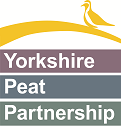At the end of January, 2018, I started a new job with Yorkshire Peat Partnership. I knew a little bit about peat - my degree is in Environmental Studies - and, fortunately, the interview was about communications skills rather than blanket bog ecology. I can safely say that 14 months on, I'm only just beginning to grasp how much I didn't know. If you have the same starting point as I did, here are just some of the things I have learned...
You're not supposed to be able to see the peat...
I've been striding about the southern Yorkshire Dales for the thick end of 40 years now, and I'd taken a real dislike to peat in that time. Plover Hill, Buckden Pike, Fountain's Fell, Firth Fell, Simon's Seat, Yockenthwaite Moor, Great Whernside, Little Whernside, actual Whernside - all routes that had brought me into contact with sucking, black glop (that's definitely a word). Peat had me wading or hopping from rock to rock or sidetracking for hundreds of metres to avoid its cold, wet embrace. But it's not peat's fault - it's our fault. Where peat is exposed like that, it's almost always because of something we've done (society as a whole, I mean, not walkers). On healthy Dales peatland, which is to say blanket bog, there should be a...well...a blanket of vegetation between you and the peat. It will still be wet - you'll want waterproof boots and gaiters - but it should support your weight, provided you keep moving.
Fun peat fact: there are more solids in a pint of milk than there are in a pint of peat. Milk is around 87% water and peat around 90%.






